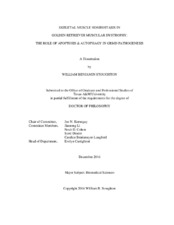| dc.contributor.advisor | Kornegay, Joe N | |
| dc.creator | Stoughton, William Benjamin | |
| dc.date.accessioned | 2017-03-02T16:48:35Z | |
| dc.date.available | 2018-12-01T07:21:24Z | |
| dc.date.created | 2016-12 | |
| dc.date.issued | 2016-11-16 | |
| dc.date.submitted | December 2016 | |
| dc.identifier.uri | https://hdl.handle.net/1969.1/159037 | |
| dc.description.abstract | Duchenne muscular dystrophy (DMD) is an X-linked recessive genetic disorder caused by mutations in the DMD gene, which results in loss of the dystrophin protein and cyclic muscle degeneration and regeneration. The main animal models include the mdx mouse and golden retriever muscular dystrophy (GRMD) dog. Dogs with GRMD have more severe disease than mice, in keeping with DMD. Variable disease expression in GRMD at the individual and muscle level provides an excellent platform to study the pathophysiology of muscular dystrophy beyond the primary effects of dystrophin loss. Autophagy and apoptosis have recently been identified as suitable secondary therapeutic targets. We sought to explore their role in GRMD pathogenesis through gene and protein expression assays and light and transmission electron microscopy.
Our initial studies focused on expression of an anti-apoptotic protein, APIP, in the differentially affected cranial sartorius (CS) and vastus lateralis (VL) muscles. We hypothesized that inhibition of apoptosis by APIP would be beneficial but, instead, found that VL protein levels tracked with a more severe phenotype. APIP was primarily expressed in regenerating fibers and inflammatory cells, perhaps providing an additional clue to its role in dystrophic muscle. Expression in regenerating fibers could be tied to anti-apoptotic activity or methionine metabolism.
Next, we investigated the role of autophagy, again focusing on the CS and VL. We hypothesized that autophagy would be reduced in GRMD muscle and be characterized by lower autophagy gene and protein (i.e., LC3B-II) expression and higher p62 levels. FOXO3 regulated genes were lower than normal in the GRMD CS, however contrary to our hypothesis, LC3B-II and p62 levels were higher in the dystrophic muscle, indicating impaired autophagy which correlated with a more severe phenotype. Autophagic structures were found in necrotic myofibers and inflammatory cells, suggesting dual roles. Treatment with an NF-κB inhibitor activated autophagy gene expression in a muscle-dependent way in treated GRMD dogs, generally in line with an improved phenotype.
In summary, apoptosis and autophagy are important in maintaining muscle homeostasis in the GRMD dog. Future studies are required to determine how APIP influences muscle regeneration and how autophagy activation can modulate GRMD pathogenesis. | en |
| dc.format.mimetype | application/pdf | |
| dc.language.iso | en | |
| dc.subject | Golden retriever muscular dystrophy | en |
| dc.subject | autophagy | en |
| dc.subject | apoptosis | en |
| dc.subject | APIP | en |
| dc.title | Skeletal Muscle Homeostasis in Golden Retriever Muscular Dystrophy: The Role of Apoptosis & Autophagy in GRMD Pathogenesis | en |
| dc.type | Thesis | en |
| thesis.degree.department | Veterinary Integrative Biosciences | en |
| thesis.degree.discipline | Biomedical Sciences | en |
| thesis.degree.grantor | Texas A & M University | en |
| thesis.degree.name | Doctor of Philosophy | en |
| thesis.degree.level | Doctoral | en |
| dc.contributor.committeeMember | Cohen, Noah D | |
| dc.contributor.committeeMember | Dindot, Scott V | |
| dc.contributor.committeeMember | Li, Jianrong | |
| dc.contributor.committeeMember | Brinkmeyer-Langford, Candice | |
| dc.type.material | text | en |
| dc.date.updated | 2017-03-02T16:48:35Z | |
| local.embargo.terms | 2018-12-01 | |
| local.etdauthor.orcid | 0000-0002-1015-4826 | |


